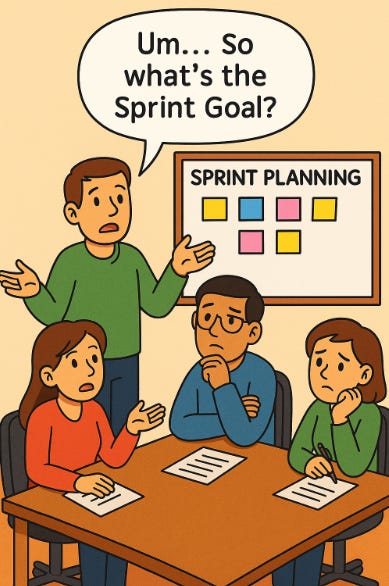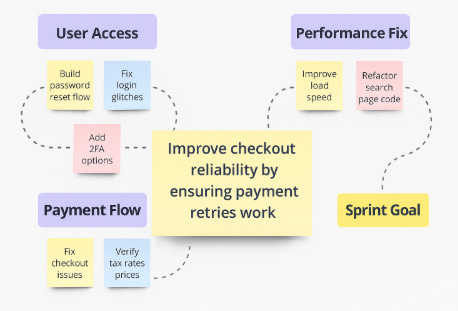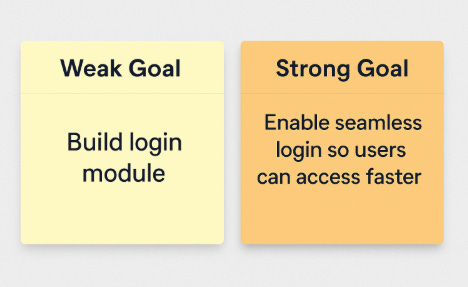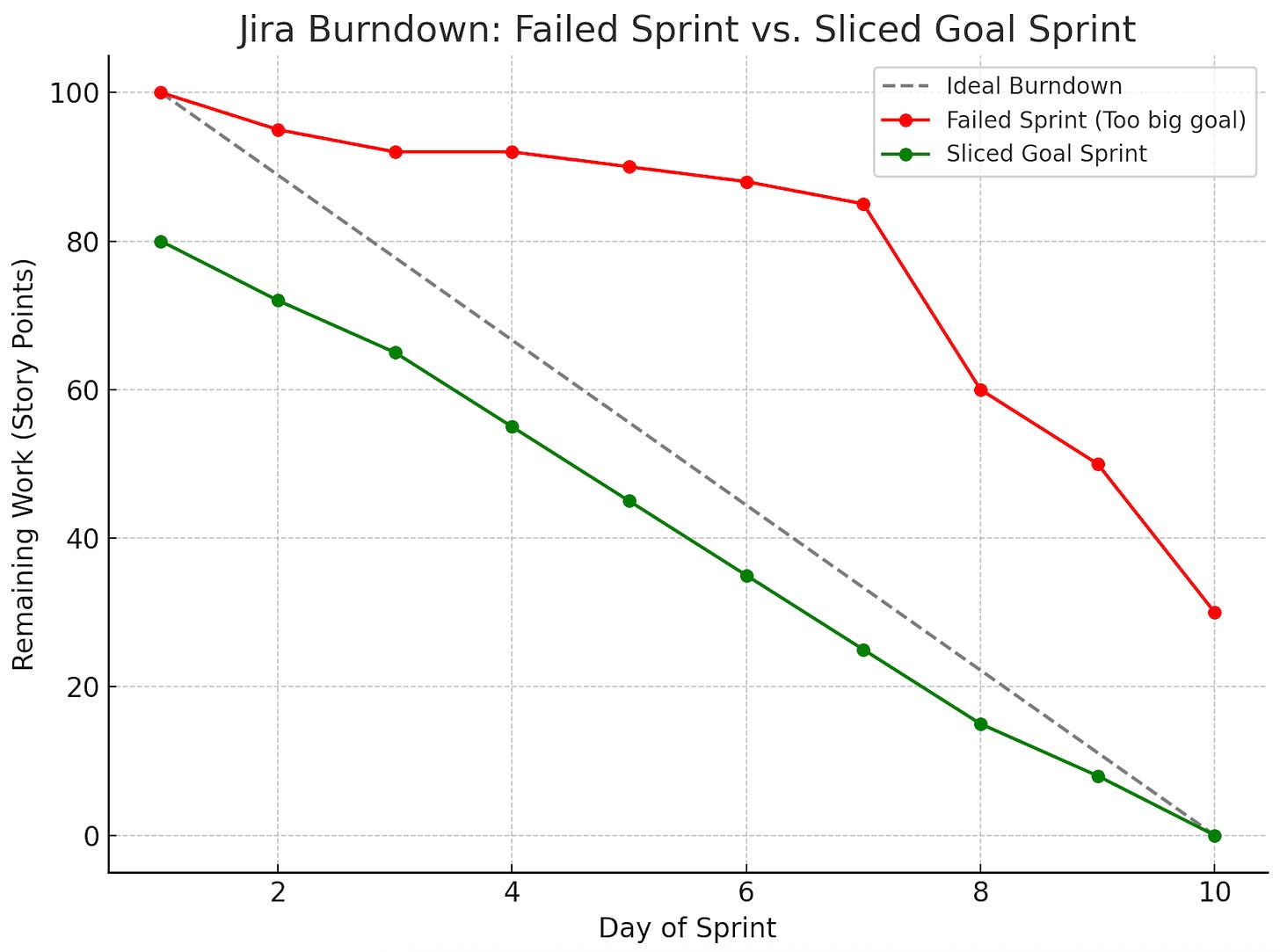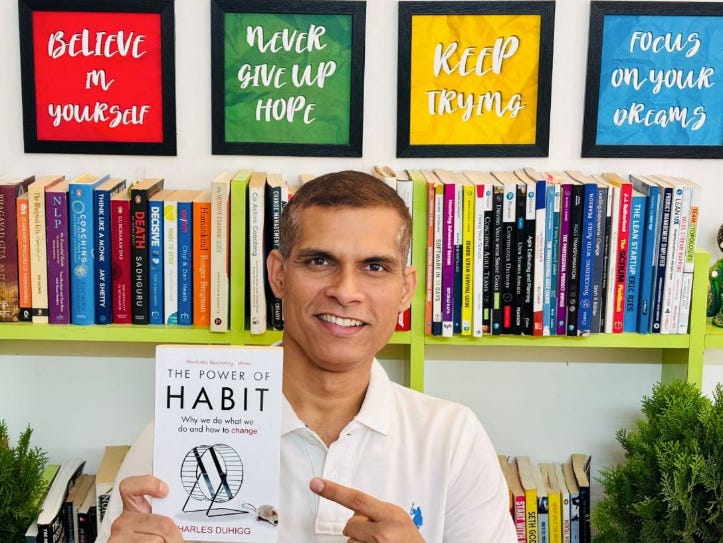The Sprint Goal Survival Guide: Helping new Teams move beyond “Just Stories” to real Outcomes
Scripts, coaching moves, and visuals to make Sprint Goals both achievable and meaningful!
I still remember my first Sprint with a new team.
Sprint Planning had started smoothly. The Product Owner had a neat backlog ready. Developers were discussing estimates. Then I asked:
“So, what’s our Sprint Goal?”
Silence.
One developer muttered: “Deliver all tickets in the Sprint backlog?”
Another said: “Can we just skip this? It feels like an extra formality.”
The Product Owner looked at me nervously. Leadership wanted meaningful Sprint Goals. The team wanted safe commitments.
That’s when it struck me: for new teams, Sprint Goals don’t come naturally. They need coaching, scaffolding, and clarity before they can set goals that are both achievable and valuable.
Here’s the survival guide I now use to coach teams through this.
Strategy 1: Anchor Goals to One Business Outcome
Step-by-step actions:
In Sprint Planning, don’t start with stories. Start with the question:
“If we succeed this Sprint, what will be different for our users or business?”Write down 3–4 possible outcomes (not features) on a whiteboard.
Example: “Users can reset passwords without support,” not “Build reset password feature.”Narrow the list to 1 outcome that is clear, testable, and achievable in 1 Sprint.
Put this sentence as the Sprint Goal at the very top of your backlog tool (Jira, Trello, Azure Boards).
Challenge: Team slips back into “Deliver all 12 stories.”
Tip (what I did): Say: “Velocity is how fast we run. Sprint Goal is where we’re running. Let’s choose where first.”
Strategy 2: Run a Sprint Goal Workshop Instead of Forcing It
Step-by-step actions:
Give everyone sticky notes (physical or Miro board).
Ask: “What could be the single most valuable outcome of this Sprint?”
Set a 5-minute timer. Each person writes 2–3 ideas.
Cluster notes into themes (e.g., “User access,” “Performance fix,” “Payment flow”).
As a team, vote (dot voting) on the strongest theme.
Craft one statement together, e.g., “Improve checkout reliability by ensuring payment retries work.”
Challenge: Developers worry: “If we miss one story, we’ve failed.”
Tip: Reframe: “Sprint Goal isn’t about completing 100% stories. It’s about delivering the essence of value. Even if one task slips, the goal can still be met.”
Strategy 3: Test Goals With the “So What?” Rule
Step-by-step actions:
Once a draft goal is written, pause. Ask: “So what if we achieve this?”
If the answer is: “We close tickets” → reject it. That’s not value.
Push for answers like: “Users will no longer call support for password resets,” or “Revenue loss from failed checkouts will drop.”
Refine wording until it speaks to real impact (not tasks).
Challenge: POs sometimes say: “But leadership just wants to see work done.”
Tip: Push back gently: “They want business impact. If we show impact, they’ll care more than just ticket counts.”
Strategy 4: Make Goals Sprint-Sized
Step-by-step actions:
When a proposed goal sounds too big, ask: “Can this be done fully in 2 weeks?”
If not, guide slicing:
Break by user journey (e.g., login → password reset → 2FA).
Break by happy path vs. edge cases.
Break by vertical slice (UI + backend for one flow).
Validate scope with developers: “Is this slice small enough for us to deliver and still be valuable?”
Confirm with PO: “If we stop here, will stakeholders still see value?”
Challenge: Stakeholders insist on big “feature goals.”
Tip: Show evidence from past failed goals vs. successful smaller ones:
“See, when we aimed too big, we missed. When we sliced smaller, we delivered and built trust.”
Strategy 5: Celebrate the Goal, Not Just Velocity
Step-by-step actions:
At Sprint Review, always open with the Sprint Goal:
“Our goal was to enable profile editing without support. Here’s what we achieved.”Demonstrate working features in relation to the Goal (not ticket numbers).
Highlight business/user impact achieved: “Support tickets dropped by 20% this week.”
Celebrate partial success if the outcome was still reached.
Challenge: Leaders keep asking: “What’s the velocity?”
Tip: Redirect: “Velocity shows effort. Sprint Goal shows impact. Let me show the impact first.”
Quick Win
In your next Planning, draft one Sprint Goal before discussing stories.
Ask the team: “Does this feel achievable in two weeks and meaningful for our users?”
If they nod, you’re on the right track.
Community of Practice
Want to practice these conversations live and hear how peers handle them?
Join my Community of Practice (CoP) every Thursday.
🔗 Register here: https://us06web.zoom.us/meeting/register/F7gCXffeR5WhLOcoeVVc4w
Ready to Turn These Strategies into Action?
Join the Scrum Master Bootcamp!
Want to put these strategies into action and experience the impact firsthand? Join my Scrum Master Bootcamp, where you’ll work through these exact challenges and build the skills needed to drive real value in your team. This isn’t just theory — it’s hands-on practice that will transform how you manage leadership’s expectations.
👉 Click to explore more and start mastering the tools and techniques that can change the way you work as a Scrum Master.
Don’t just learn — experience the difference in real time.
📚 From My Shelf
This Week’s Book: The Power of Habit by Charles Duhigg
(A brilliant read on why we do what we do.)
In his book Charles Duhigg doesn’t talk about willpower alone.
He talks about cues, routines, and rewards, the hidden loop that drives human behaviour.
This kind of awareness helps us understand and replace destructive habits with empowering ones.
Overall, "The Power of Habit" offers a comprehensive guide to understanding and transforming our habits, making it a valuable resource for personal and professional growth.
The most influential sentences in the book for me were-
“Change might not be fast and it isn’t always easy. But with time and habit, almost any pattern can be reshaped.”
📖 For any Scrum Master or Product Owner leading teams—this book is a masterclass in building lasting change through small, repeatable actions.
Why Subscribe
Each week, I share battle-tested strategies, messy lessons, and practical tools that help Scrum Masters, Product Owners, and change agents like you make sense of chaos — without sugar-coating it.
If you found this useful, subscribe.
This isn’t theory. It’s real work, made a little easier — one step at a time.
Thanks for reading Strategy For Success! Subscribe for free to receive new posts and support my work.
“Just because I understand it, does not mean everyone understands it. And just because I do not understand it, does not mean no one understands it.”
Thanks for reading Strategy For Success! Subscribe for free to receive new posts and support my work.


